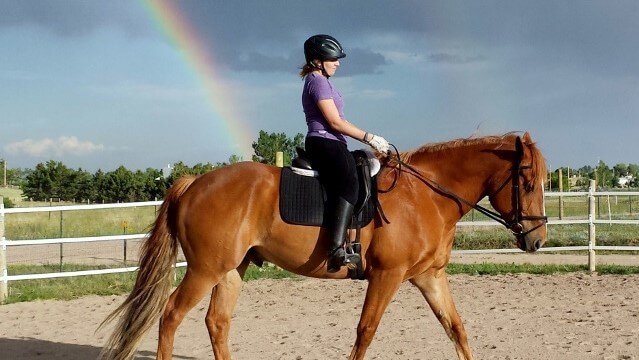Does your horse go better out of the arena? It seems like some horses just won’t go forward and no amount of kicking and yelling work. Sometimes they’re gate sour: fast toward the gate but then getting away from the gate is a wrestling match. Horses who are great on the trail become cranky and drag their toes in the arena, counter-bent and tense.
Riders tell me that their horse is bored in the arena. I notice that there is a predictable coincidence between how a rider feels about things and how her horse responds.
It goes like this: we head into the arena on a horse who’s sound and happy when ridden in the pasture. In the arena, things change. Even if there’s no traffic, the rail beckons. And for the first time, his feet need to be micromanaged, so we use our reins more than in the pasture. There are actual corners to navigate and he’s nowhere near where he belongs, so even more steering with our hands. We correct each stride, not noticing it’s already too late for him to make it.
Maybe there are dressage letters posted and we decide to circle at B, but start late, acting like there’s a cliff if we miss the letter. One more hard pull with the inside rein. Naturally, he pulls back and tosses his head. Then we correct him even louder because the position of the silly letter means he’s wrong.
Add to that the fact most riders feel watched, even if no one is there. We get self-conscious. Invisible railbirds must be judging us…so we decide to out-judge them, as if skill is defined by being our own worst critic.

Then, we over drill the horse: Go closer to the rail, more bend, kick harder hoping for a quicker response. He thinks he’s doing what he’s being asked, but the cueing continues. There’s no release or reward, so he loses confidence and tries something else. While trying to find what we want, he stops doing the right thing. Then we ask again, just one more and we can quit, but he has given you a stack of good tries already and now he’s just done.
The horse’s opinion of arena work is simple. “Everything I do is wrong.” That sounds just like I hate the arena. We don’t like who we are in the arena, either. Did no one ever teach us to say thank you?
To add insult to injury, here comes someone on a horse, smiling and laughing while her horse is doing beautiful, complicated work. She looks like she isn’t even trying. We’re frustrated and some giggle-puss glides by.
Sometimes riding in the arena gets too precious. It’s true that every moment you’re in the saddle, you’re training your horse. The bad news is you were training your horse to hate the arena. The good news is you can change that by shifting your attitude. Instead of fighting what just happened, look ahead.
Less Correction, More Direction
If your horse is better out of the arena, ride as if the arena is a huge meadow and there’s no wrong place to be. Let him move out. Go on a long rein and give him twenty minutes to warm his joints. Then pat him, and say good boy.
Ride like nobody’s watching. If you aren’t prepared for the circle by B, then do it when you are ready. Have a plan for the ride, but don’t care about it too much.
Change things up. In dressage, we hold a horse’s attention by doing transitions. Step one is to ride freely, to encourage a supple and fluid body. When you canter, ride for the horizon. When you walk, breathe slowly like you’re passing a pond. If you get stuck in a corner without a plan, go to the default plan; laugh and start over. Partners don’t blame each other.
Because in this perfect moment, whether it’s a mountain meadow or inside a dusty indoor arena, remember you’re in a sacred place, being lifted and carried by a horse. Today is irreplaceable. Thank him every chance you get.
Published in the September 2020 Issue:

Anna Blake is a horse advocate, trainer, international clinician, and award-winning author of five books. Anna believes affirmative training principals build a relaxed and forward foundation that crosses over all riding disciplines in the same way that the understanding calming signals benefits all equine communication.
Want more? Visit annablake.com to see our class schedule, online courses available on a revolving basis on Calming Signals, Affirmative Training, and more. You can purchase books or schedule a live consultation or lesson, subscribe for email delivery of her popular blog, or ask a question about the art and science of working with horses. Join us in The Barn, our online training group with video sharing, audio blogs, live-chats with Anna, and much more.

